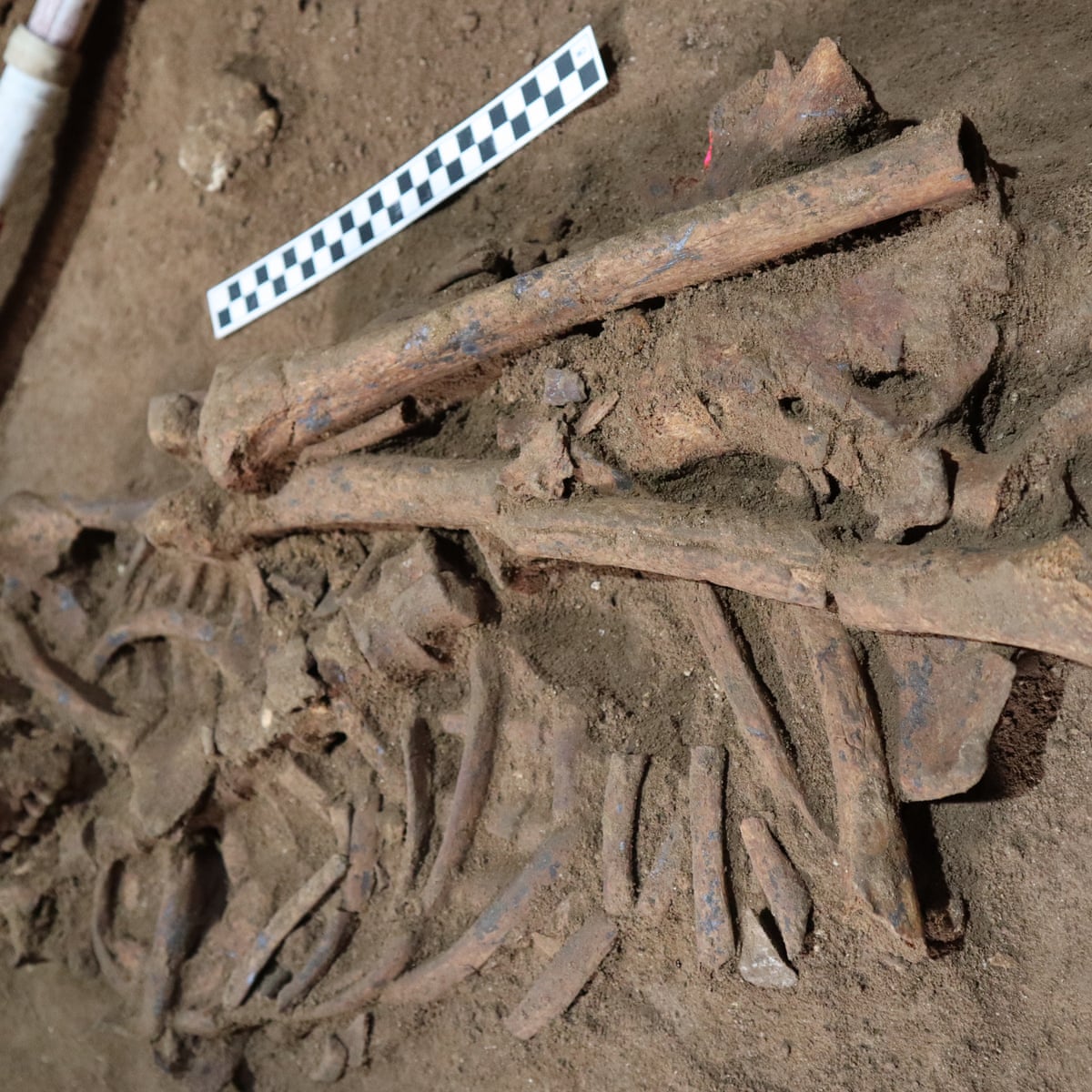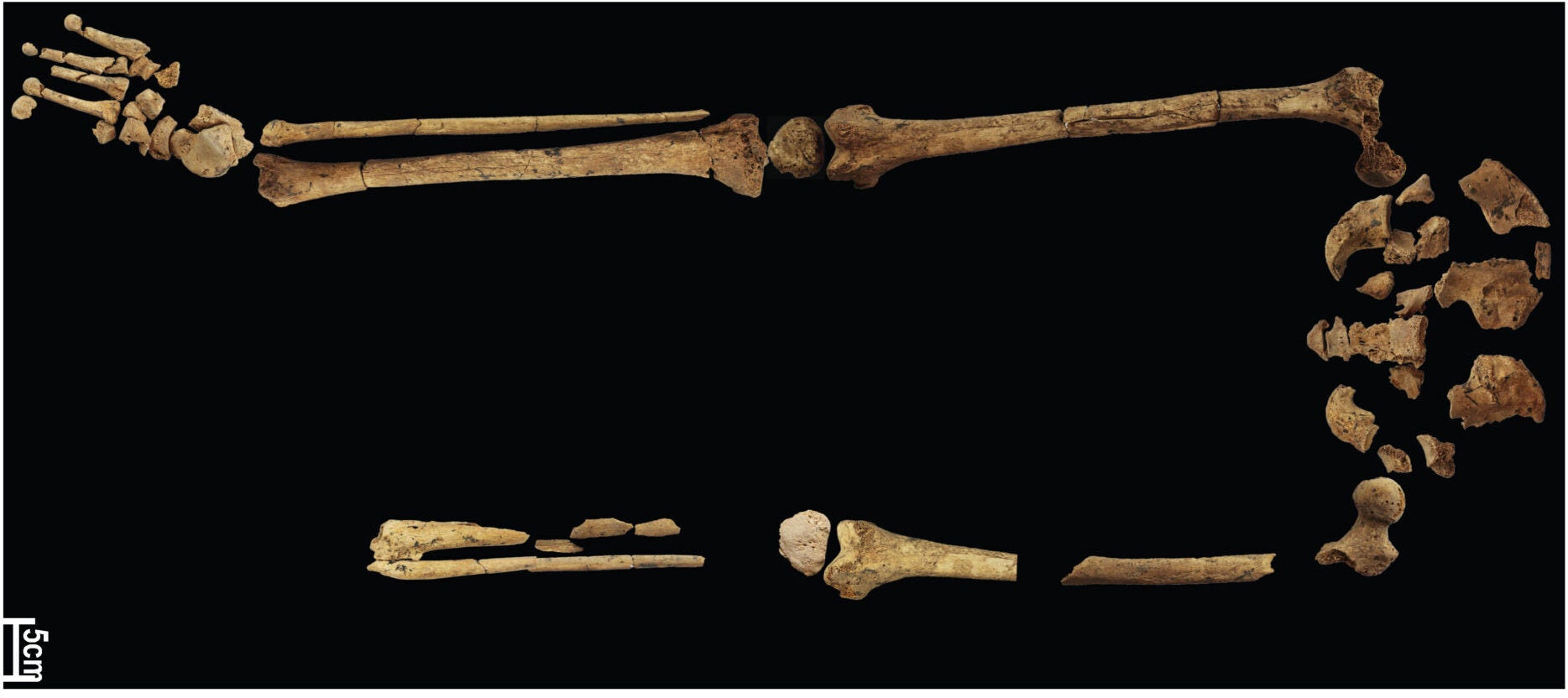Finding by Australian and Indonesian archaeologists in remote Borneo cave rewrites understanding of human history

Australian and Indonesian archaeologists stumbled upon the skeletal remains of a young hunter-gatherer whose lower leg was amputated by a skilled surgeon 31,000 years ago. Photograph: Tim Maloney
A 31,000-year-old skeleton missing its lower left leg and found in a remote Indonesian cave is believed to be the earliest known evidence of surgery, according to a peer-reviewed study that experts say rewrites understanding of human history.
An expedition team led by Australian and Indonesian archaeologists stumbled upon the skeletal remains while excavating a limestone cave in East Kalimantan, Borneo looking for ancient rock art in 2020.
The finding turned out to be evidence of the earliest known surgical amputation, pre-dating other discoveries of complex medical procedures across Eurasia by tens of thousands of years.
By measuring the ages of a tooth and burial sediment using radioisotope dating, the scientists estimated the remains to be about 31,000 years old.
Palaeopathological analysis of the remains revealed bony growths on the lower left leg indicative of healing and suggesting the leg was surgically amputated several years before burial.
Dr Tim Maloney, a research fellow at Australia’s Griffith University who oversaw the excavation, said the discovery was an “absolute dream for an archaeologist”.

View of the archaeological excavation at Liang Tebo cave which unearthed the 31,000-year-old skeletal remains. Photograph: Tim Maloney
He said the research team, which included scientists from the Indonesian Institution for Archaeology and Conservation, was examining ancient cultural deposits when they crossed stone markers in the ground revealing a burial site.
After 11 days of excavation, they found the skeleton of a young hunter-gatherer with a healed stump where its lower left leg and foot had been severed.
Maloney said the nature of the healing, including the clean stump showed it was caused by amputation and not an accident or animal attack.
“[The hunter] survived not just as a child, but as an adult amputee in this rainforest environment,” Maloney said. “Importantly, not only does [the stump] lack infection, but it also lacks distinctive crushing.”
/cloudfront-us-east-1.images.arcpublishing.com/gray/FCUSK6UORFHJTMTJ37ZIZ5WSF4.jpg)
Archaeologists at work in Liang Tebo cave in the remote Sangkulirang-Mangkalihat region of East Kalimantan. Photograph: Tim Maloney
Prior to this discovery, Maloney said it had been widely accepted that amputation was a guaranteed death sentence until about 10,000 years ago, when surgical procedures advanced with the development of large settled agricultural societies.
The previous oldest evidence of a successful amputation was a 7,000-year-old skeleton of an elderly farmer from stone age France. His left arm was amputated above the elbow.
“This finding very much changes the known history of medical intervention and knowledge of humanity,” Maloney said.
“It implies that early people … had mastered complex surgical procedures allowing this person to survive after the removal of a foot and leg.”
Maloney said the stone age surgeon must have had detailed knowledge of anatomy, including veins, vessels and nerves, to avoid causing fatal blood loss and infection.
He said the successful operation suggested some form of intensive care, including regular disinfection post-operation.
Emeritus Prof Matthew Spriggs of the Australian National University School of Archaeology and Anthropology, who was not involved in the study, said the discovery was “an important rewrite of our species history” that “underlines yet again that our ancestors were as smart as we are, with or without the technologies we take for granted today”.
Spriggs said it should not be surprising that stone age people could have developed an understanding of the internal workings of mammals through hunting, and had treatments for infection and injury.
“We tend to forget that modern humans like us 30,000 years ago … would have had their intellectuals, their doctors, their inventors,” he said.
He said they would have had to experiment with plant medicines and other treatments to stay alive.
“Any inhabitants of tropical rainforests today, usually now mixing hunting and gathering with forms of agriculture, have a large pharmacopoeia that would have to have been developed over millennia.”
The study was published in the journal Nature.
… as you’re joining us today from Vietnam, we have a small favour to ask. Tens of millions have placed their trust in the Guardian’s fearless journalism since we started publishing 200 years ago, turning to us in moments of crisis, uncertainty, solidarity and hope. More than 1.5 million supporters, from 180 countries, now power us financially – keeping us open to all, and fiercely independent.
Unlike many others, the Guardian has no shareholders and no billionaire owner. Just the determination and passion to deliver high-impact global reporting, always free from commercial or political influence. Reporting like this is vital for democracy, for fairness and to demand better from the powerful.

The skeletal remains showing the amputated lower left leg. Photograph: Tim Maloney
And we provide all this for free, for everyone to read. We do this because we believe in information equality. Greater numbers of people can keep track of the events shaping our world, understand their impact on people and communities, and become inspired to take meaningful action. Millions can benefit from open access to quality, truthful news, regardless of their ability to pay for it.
Every contribution, however big or small, powers our journalism and sustains our future. Support the Guardian from as little as $1 – it only takes a minute. If you can, please consider supporting us with a regular amount each month. Thank you.